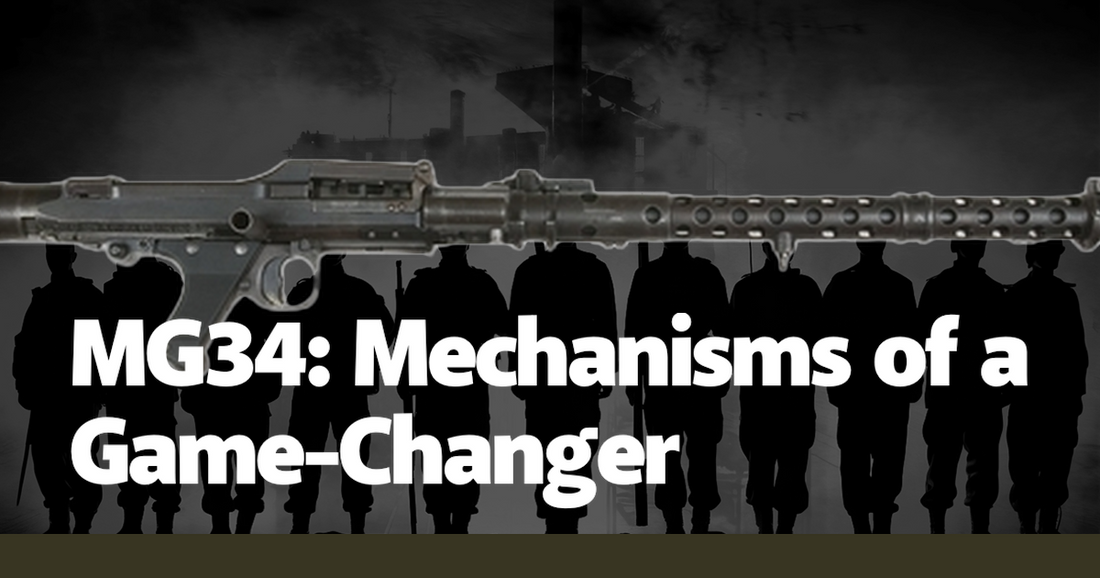The MG34, a machine gun that revolutionized infantry tactics, was a marvel of engineering and a symbol of German military innovation during World War II. Introduced in 1934, it was the brainchild of Heinrich Vollmer and the Mauser company, designed to provide the Wehrmacht with unparalleled firepower. The MG34 was not just a weapon; it was a game-changer that redefined the role of machine guns on the battlefield. Its versatility allowed it to serve in various roles, from light machine gun duties to anti-aircraft defense, making it an indispensable tool for German forces. The MG34's impact on warfare cannot be overstated, as it set the standard for machine gun design and influenced countless subsequent models.
One of the most remarkable features of the MG34 was its rate of fire. Capable of firing 800 to 900 rounds per minute, it was significantly faster than its contemporaries. This high rate of fire was achieved through a recoil-operated mechanism that utilized a short-recoil system. When a round was fired, the barrel and bolt recoiled together for a short distance before unlocking, allowing the bolt to continue rearward and eject the spent cartridge. This design not only facilitated rapid firing but also ensured reliable operation under various conditions. The MG34's ability to deliver such a high volume of fire made it a formidable weapon, capable of overwhelming enemy forces and providing critical support to advancing infantry.
The MG34's versatility extended beyond its rate of fire. It was designed to be easily adaptable to different roles, thanks to its modular construction. The gun could be mounted on a bipod for use as a light machine gun, or on a tripod for sustained fire as a medium machine gun. Additionally, it could be fitted with a variety of sights, including optical sights for long-range engagements and anti-aircraft sights for targeting enemy aircraft. This adaptability made the MG34 a flexible and valuable asset on the battlefield, capable of meeting the diverse needs of German forces. The ability to quickly switch between roles ensured that the MG34 could be deployed in a wide range of tactical situations, enhancing its effectiveness and utility.
The MG34's impact on infantry tactics was profound. Prior to its introduction, machine guns were often heavy, cumbersome, and difficult to maneuver. The MG34's relatively lightweight design, at around 12 kg, allowed it to be more easily transported and deployed by infantry units. This mobility enabled German forces to implement more dynamic and aggressive tactics, utilizing the MG34 to provide suppressive fire and support rapid advances. The gun's quick-change barrel system also allowed for sustained fire without the risk of overheating, a critical feature during prolonged engagements. By enabling more fluid and flexible tactics, the MG34 played a key role in the success of German Blitzkrieg strategies, which relied on speed and surprise to overwhelm enemy defenses.
The MG34's influence extended beyond the battlefield, as it set a new standard for machine gun design and production. Its innovative features and high-quality construction inspired the development of subsequent models, including the famous MG42. The MG42, often considered the pinnacle of machine gun design, built upon the foundations laid by the MG34, incorporating improvements such as a simplified production process and an even higher rate of fire. The legacy of the MG34 is evident in the continued use of similar mechanisms and design principles in modern machine guns. Its impact on the evolution of military technology and tactics is a testament to the ingenuity and foresight of its designers.
Despite its many advantages, the MG34 was not without its challenges. Its complex design and precision engineering made it expensive and time-consuming to produce. The gun's sensitivity to dirt and debris also required meticulous maintenance to ensure reliable operation. These factors limited the MG34's widespread adoption and prompted the development of the more robust and cost-effective MG42. Nevertheless, the MG34 remained in service throughout the war, valued for its accuracy and versatility. Its continued use, even in the face of newer models, speaks to the enduring effectiveness and reliability of its design. The MG34's ability to adapt and perform under various conditions ensured its place as a cornerstone of German military firepower.
Anecdotes from the front lines highlight the MG34's impact on soldiers and their experiences in combat. Veterans often recounted the sense of confidence and security that came from having an MG34 in their unit. Its rapid rate of fire and accuracy provided a psychological advantage, demoralizing enemy troops and boosting the morale of German forces. Stories of MG34 gunners holding off superior enemy numbers or providing critical cover during retreats underscore the gun's importance in the heat of battle. These personal accounts offer a glimpse into the human side of the MG34's legacy, illustrating how it shaped the experiences and outcomes of those who wielded it.
The MG34's legacy endures in the annals of military history, a testament to its groundbreaking design and battlefield effectiveness. Its introduction marked a turning point in the development of machine guns, setting new standards for performance and versatility. The lessons learned from the MG34's design and deployment continue to inform modern military technology and tactics. As a symbol of innovation and adaptability, the MG34 remains a subject of fascination and study for historians, engineers, and military enthusiasts alike. Its story is a reminder of the profound impact that a single piece of technology can have on the course of history, shaping the strategies and outcomes of conflicts for generations to come.

